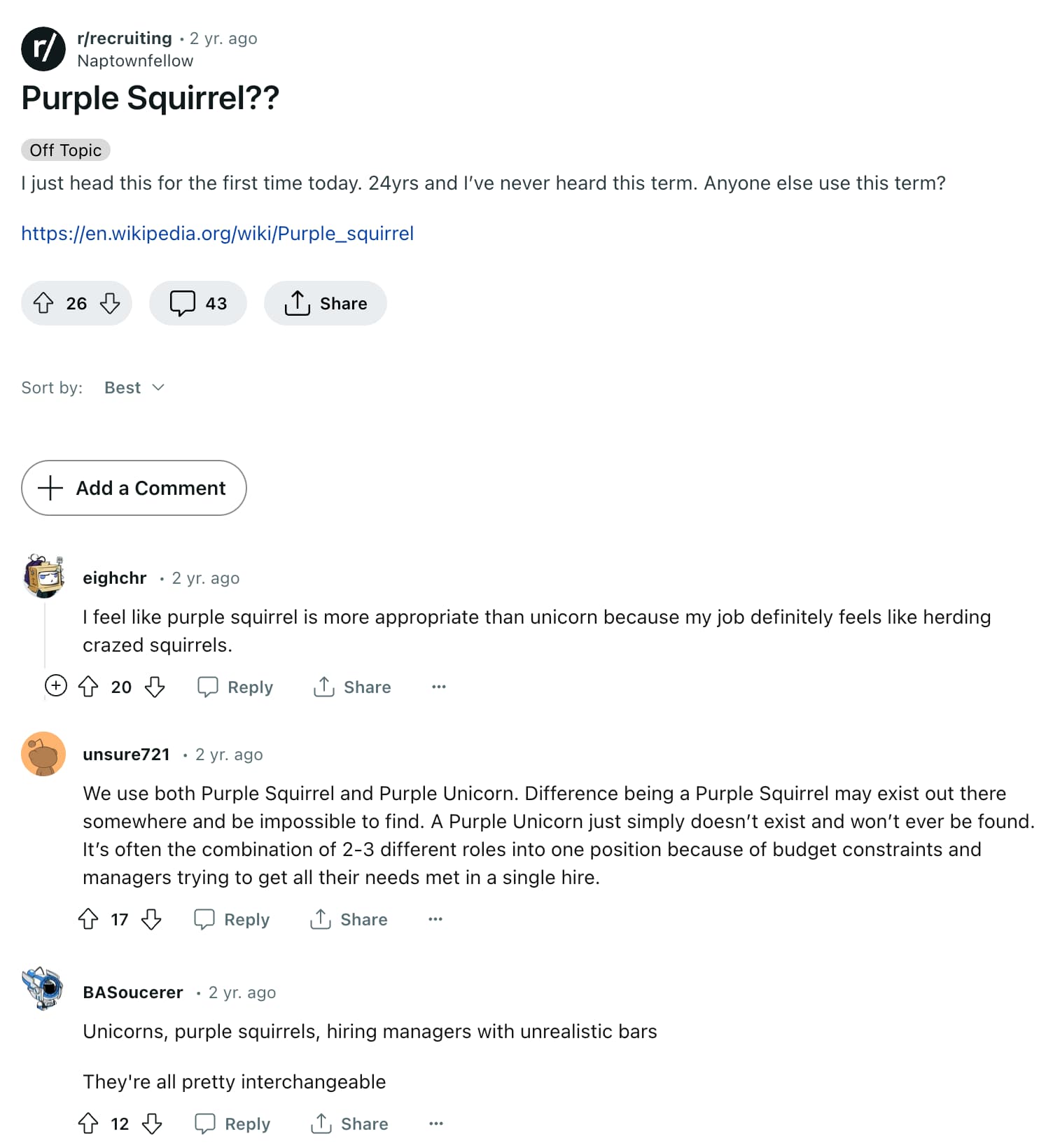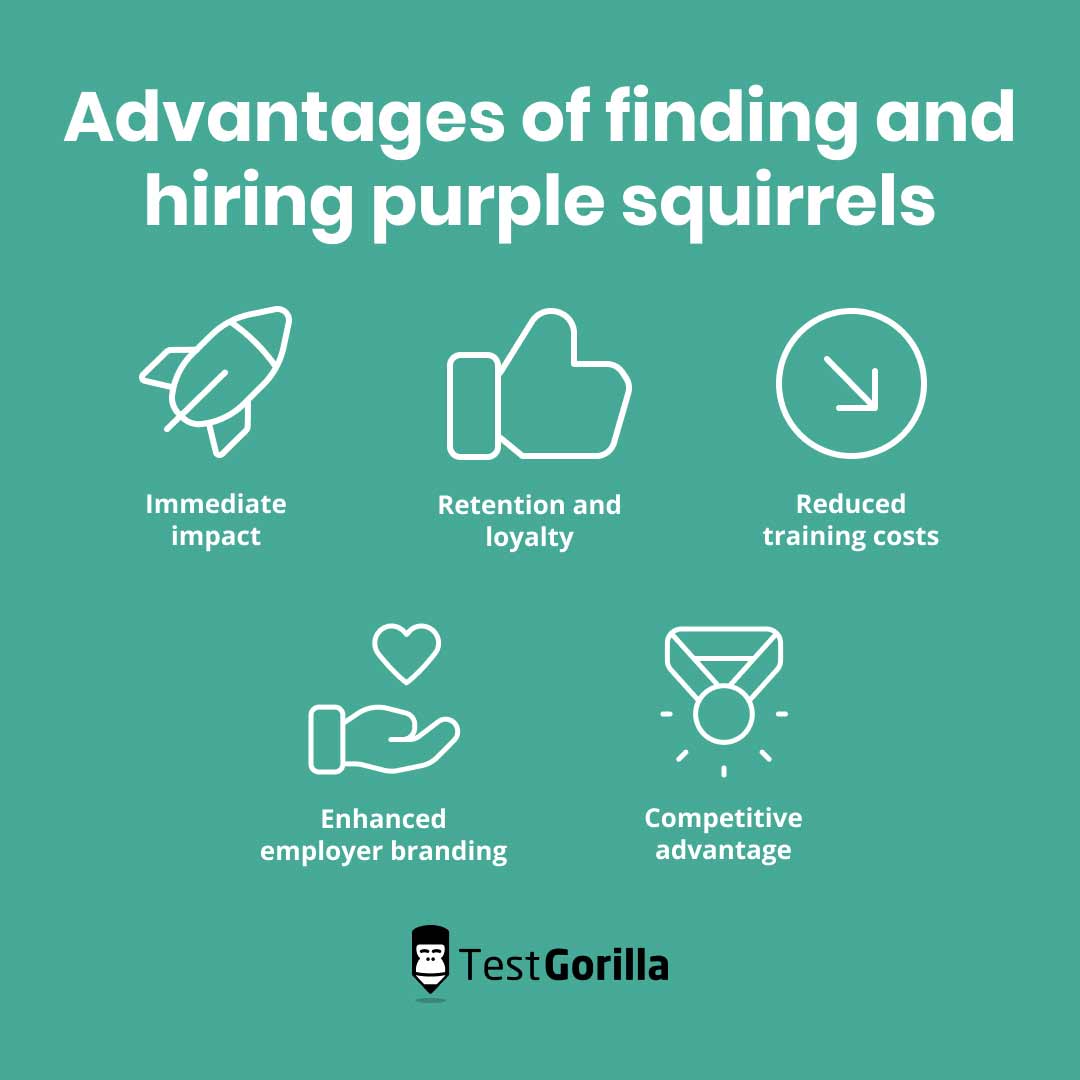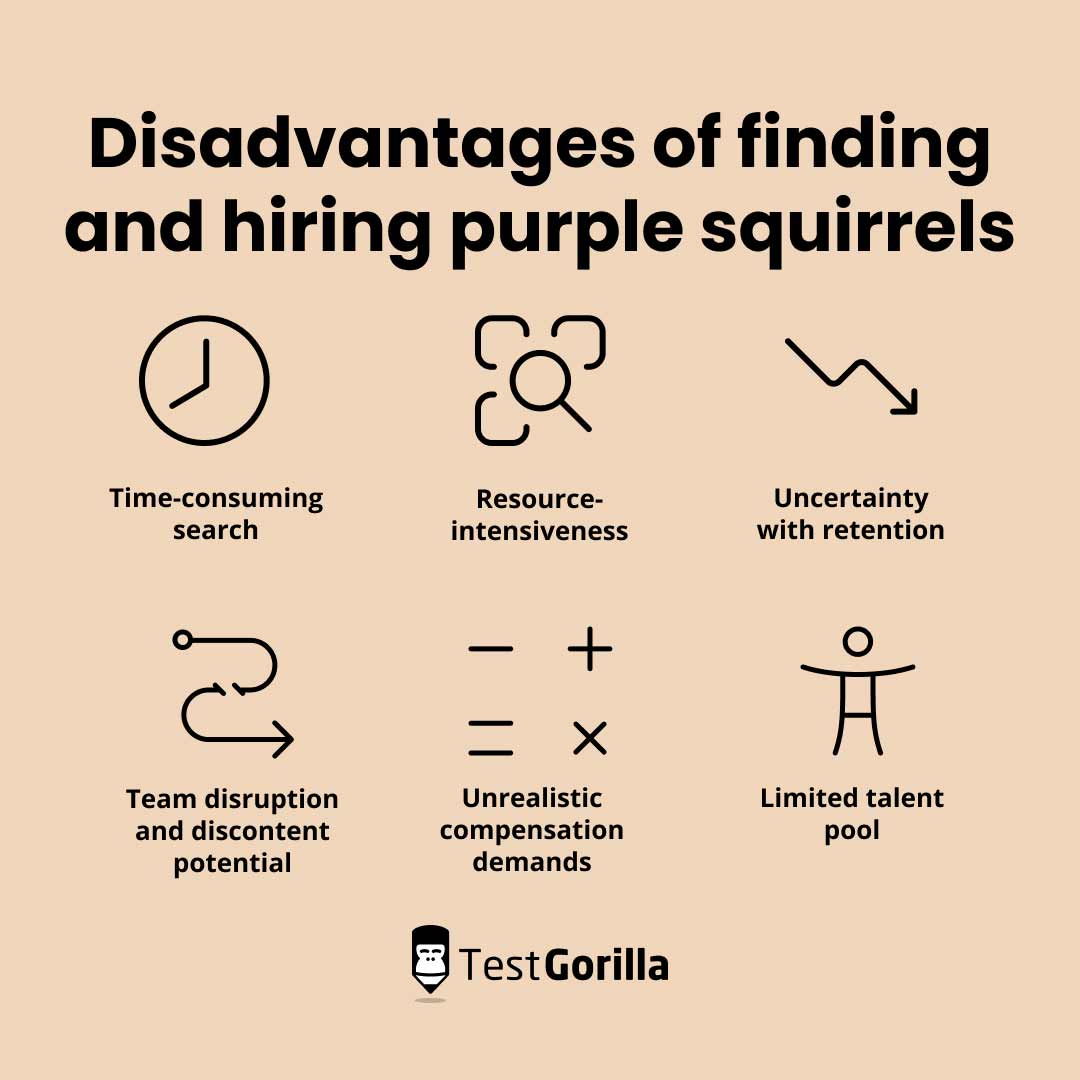Recruiting purple squirrels: A rare breed or an unrealistic ideal?
Finding and hiring top talent can be a lengthy process, taking an average of 54 days for non-executives and 62 days for executive roles. [1] What's more, recruiting the perfect candidate can feel like an (almost) impossible search for finding purple squirrels.
Purple squirrels?
Recruiters often use the term purple squirrel to refer to rare individuals who possess a unique combination of skills, set of experience, and personality traits that perfectly match the requirements of a particular job opening.
But do these mythical candidates exist? If so, it would be nice to have a way to find them (no magical potions required!).
In this comprehensive guide, we'll delve into the concept of purple squirrels, verify their existence, potential benefits, and the associated drawbacks of finding one.
You'll also learn practical strategies for identifying and attracting top talent, with emphasis on the skills-based hiring as a more realistic approach to making great hires.
Table of contents
- What is a purple squirrel in recruiting?
- Do purple squirrels in recruitment exist?
- Are hiring purple squirrels worth it?
- Purples squirrels and its impact on diversity in the workplace
- Where to find purple squirrels
- Tips and best practices in attracting purple squirrels to your organization
- 5 factors to consider when pursuing the elusive purple squirrel
- Chasing purple squirrels vs. skills testing
- Forget purple squirrels— use skills testing to find and hire the best
What is a purple squirrel in recruiting?
In recruitment circles, a purple squirrel refers to passive candidates who are, in every way, perfect for an open position in your organization. It's like stumbling upon the mythical unicorn in the talent jungle.
Imagine finding a software engineer who's not just a coding maestro but also has a black belt in graphic design and is fluent in SEO. This is the level of rarity we're talking about.
The term purple squirrel has been in use, most likely since 2000. A 2010 article published by CBS with the headline "Purple Squirrels Now in Demand," described how employers are trying to do more with fewer workers and prefer employees who can perform a wide range of tasks like "purple squirrels."
Do purple squirrels in recruitment exist?
While purple squirrels are more of a metaphorical concept, there are instances where job candidates with scarce skill sets exist. However, finding them is like looking for a needle in a haystack.
The specific combination of skills, experience, right education, and personality traits required for a purple squirrel often make these sought-after candidates difficult to find, especially within a limited timeframe.
The best insights on HR and recruitment, delivered to your inbox.
Biweekly updates. No spam. Unsubscribe any time.
Are hiring purple squirrels worth it?
Let's say you've found a purple squirrel candidate or are contemplating the pursuit. But is it worth the chase? Let's break it down with some pros and cons.
Advantages of finding and hiring purple squirrels
Hiring purple squirrels can offer several advantages to an organization. These include the following:
1. Immediate impact
As a high performer, a purple squirrel can often make an immediate and significant contribution to the company due to their unique combination of skills and experience. They may bring fresh perspectives, innovative ideas, and a high level of expertise, leading to improved productivity, efficiency, and overall performance.
2. Retention and loyalty
Purple squirrels are often highly engaged and satisfied with their jobs, leading to lower turnover rates and increased employee loyalty. They may feel valued and appreciated, fostering a sense of belonging and commitment to the company.
3. Reduced training costs
As new hires, purple squirrels may require minimal training or new employee onboarding due to their existing skills and experience. This can save your company time and resources, allowing you to focus on more strategic initiatives.
4. Enhanced employer branding
Hiring purple squirrels can enhance your company's reputation as an employer of choice. As a result, you attract other top talent and strengthen your position in the candidate market.
5. Competitive advantage
Finally, rare talents often come with fresh perspectives, sparking innovation within your organization.
Disadvantages of recruiting for purple squirrels
While the allure of hiring purple squirrels is tempting, you have to be aware of the potential drawbacks and challenges associated with this pursuit.
1. Time-consuming search
Tracking down a purple squirrel is like embarking on a prolonged treasure hunt. The exhaustive search can delay crucial projects and hiring timelines. When you spend months scouting for a candidate with an ultra-rare skill set, chances are you’re missing out on other qualified and high-potential employees. .
2. Resource-intensiveness
Pursuing purple squirrels can be resource-intensive, requiring significant time, effort, and financial investment. For example, allocating a dedicated team and budget to the search for a candidate with a highly specialized skill set or unique range of qualifications could strain your recruitment resources.
3. Uncertainty with retention
Just because you've captured a purple squirrel doesn't guarantee they'll stay. After investing time and resources in recruiting a rare talent, they may receive an irresistible offer from a competitor and decide to jump ship.
4. Limited talent pool
Focusing exclusively on purple squirrels narrows your talent pool, potentially overlooking other qualified candidates.
5. Potential for disruption and discontent within the team
Introducing a purple squirrel into an existing team can disrupt dynamics, especially if they have a vastly different skill set or work style. In addition, bringing in a purple squirrel can create resentment among existing employees, especially if it's perceived as favoritism or nepotism.
6. Unrealistic compensation demands
A purple squirrel often comes with a hefty price tag. This can strain your company's budget and make it difficult to negotiate fair compensation packages.
Purples squirrels and its impact on diversity in the workplace
A diverse team is more productive, forward-thinking, and capable of putting forward more creative ideas. Companies with higher gender, racial, and ethnic diversity are more likely to have higher financial returns. Recruiters search for purple squirrels to make their teams more productive and help them reach their targets. But by pursuing purple squirrels, you may be hindering the level of diversity in your team, and this approach can lead to a lack of fresh perspectives.
As you hunt for purple squirrels to enhance your team, the opposite can often occur. You find fewer top candidates because of bias in your recruitment process. This can happen because you are constantly comparing your candidates to your ideals, and your perception of each candidate is therefore skewed.
Where to find purple squirrels
After learning the pros and cons of hiring one, you’re now set in finding a purple squirrel.
The elusive nature of purple squirrels makes them challenging to find through traditional recruiting methods. However, there are a few strategies that can increase your chances of identifying these rare candidates:
Tap into your network: Instead of hanging out at generic job boards, ask your professional connections and personal network to identify potential purple squirrels.
Attend industry events: Participate in conferences, workshops, and meetups related to your industry to network with potential candidates.
Utilize specialized recruitment agencies: Partner with specialized agencies with expertise in recruiting for niche or hard-to-find roles.
Engage with members in online forums and communities: Engage in relevant online forums or websites where potential purple squirrels may be active. For example, if you are looking for a highly specialized software developer, try joining forums that cater to that particular programming language or technology. Engage in relevant discussions and provide value to the community before reaching out to potential candidates. This can help establish your credibility and increase the chances of finding your perfect candidate.
Tips and best practices in attracting purple squirrels to your organization
Recruiting elusive purple squirrels requires a strategic and thoughtful approach.
Here are some tips and best practices to increase your chances of luring them into your talent treehouse and gaining their attention:
Craft clear, succinct job descriptions that highlight the unique aspects of the new role you're trying to fill.
Showcase compelling projects and initiatives that the candidate will work on.
Offer flexible work environments to accommodate diverse skill sets and personal pursuits.
Network in niche communities and industry events.
Be prepared to offer competitive compensation packages that reflect the rarity of their skills.
Customize your recruitment messages and outreach to emphasize the alignment between their skills and your company's goals. Avoid generic messages. Reference specific aspects of their background that make them a perfect fit for your team.
Showcase your company's commitment to investing in employees' skill development and how it aligns with their career aspirations.
Remember, attracting purple squirrels is not just about finding them; it's about creating an environment where their unique skills can flourish. Tailor your approach to each candidate, showcase your company's strengths, and be genuine when you reach out to them.
5 factors to consider when pursuing the elusive purple squirrel
If you are still determined to find the perfect hires as an HR manager or recruiter, keep the following questions in mind.
1. What is your ideal time to hire?
How long are you prepared to wait if you are searching for the ‘perfect’ candidate? Not only can a long time to hire be detrimental to the recruitment process, it can also put pressure on existing employees in terms of their workloads. Is searching for purple squirrels conducive to reducing your time to hire?
2. What are your target recruitment costs?
How much can your business afford to spend on searching for the perfect candidate throughout the recruitment process? If your recruitment process is long, you can expect to spend more when trying to find a purple squirrel. Can your company afford it? Would streamlining the recruitment process in other ways help reduce recruitment costs?
3. Is there a lack of diversity in your team?
How will you deal with a lack of diversity in your organization caused by recruiting purple squirrels? As mentioned, a lack of diversity hinders your team’s productivity and ability to innovate. Are you prepared to forgo the benefits of a productive and diverse team when chasing a candidate who is identical to your existing employees?
4. How will you avoid bias and create a positive reputation for your business?
Can your organization afford to pursue purple squirrels despite recruitment biases? Are you willing to reduce the size of your candidate pool when chasing a purple squirrel? How will you deal with a potential negative reputation caused by biases in your recruitment process?
5. How does training fit into your hiring process?
Is it better for you to choose a candidate that fits better within the organization’s culture, shares its values, and shows potential to grow with training opportunities than search for a more elusive candidate? Will you save time and end up with a more suitable employee by offering them the relevant training instead of chasing a purple squirrel?
Chasing purple squirrels vs. skills testing
Pursuing purple squirrels isn’t always the answer – particularly with all of the complex problems that can stand in your way. But getting the right candidate is more than possible with a few practical strategies.
You can streamline your recruitment process in various ways by:
Reducing the emphasis placed on resume screening
Gathering as much information as you can on your candidates in the interview process, and
Using skills testing to your advantage
Skills testing is one of the best approaches to screening candidates as it has a huge number of benefits like the following:
Wider and diverse candidate pool: Skills testing allows you to assess a broader range of most relevant candidates, expanding your talent pool beyond the narrow confines of the purple squirrel archetype.
Objective assessment: Skills tests provide an objective and data-driven evaluation of candidates' abilities, eliminating potential biases and ensuring a fair hiring process. It also enables you to compare your candidates’ aptitudes with all of your applicants and base your decisions on data, instead of a hunch or ‘gut feeling’.
Predictive of future performance: Skills tests, including personality tests, correlate strongly with future job performance, allowing you to identify high-performing candidates with the skills and aptitude to succeed in the role.
Improved efficiency: Skills testing streamlines the hiring process by quickly identifying candidates with the necessary skills, reducing time spent interviewing and evaluating unqualified candidates.
Forget purple squirrels— use skills testing to find and hire the best
Although looking for a job candidate who is a perfect hire in every way might seem like a good approach, you are most likely to encounter challenges when searching for purple squirrels. Instead, using skills testing to assess your candidates helps:
Reduce your time to hire
Reduce your recruitment costs
Increase your candidate pool
Increase the diversity of your team
Make sound recruitment decisions, and
Avoid bias in your recruitment process
Shake up your hiring process today and discover just how using skills testing can benefit your recruitment team with a free trial of TestGorilla. You can also take a quick product tour.
Source:
1. Society for Human Resource Management. (2022). Talent Access Report. SHRM. https://shrm.org/ResourcesAndTools/business-solutions/PublishingImages/Pages/benchmarking/Talent%20Access%20Report-TOTAL.pdf
You've scrolled this far
Why not try TestGorilla for free, and see what happens when you put skills first.



















